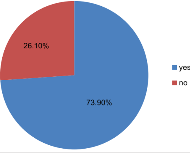Assessment of visual acuity amongst school‑aged students in Southern Cross River State, Nigeria
Main Article Content
Abstract
BACKGROUND: Visual impairment is a major public health concern worldwide, with uncorrected refractive errors as a major cause of visual impairment in children. Most of the causes of this visual impairments can be prevented or easily corrected.
AIM AND OBJECTIVES: This study seeks to determine the prevalence of visual impairment and factors responsible for visual acuity screening amongst school‑aged children in Southern Cross River State, Nigeria.
METHODOLOGY: This was a cross‑sectional descriptive designed study using a multistage sampling technique, with a self‑administered questionnaire to obtain quantitative data from school‑aged children in secondary schools in Calabar Municipality, Southern Senatorial District of Cross River State in South‑South Nigeria.
RESULTS: The mean age of respondents was 13.9 ± 2 years. The prevalence of visual impairment amongst students was 5.7%. Although majority of the respondents (73.9%) were aware of visual acuity screening test, only 33.9% of the respondents had ever had a visual acuity test done. A statistically significant association was found (P < 0.05) between those students who were aware of eye screening test, had their vision deteriorate or have their academic performance affected by their vision and the practice of performing an eye screening test.
CONCLUSION: Awareness of visual acuity screening did not translate into practice, so it is necessary for visual acuity screening test to be made mandatory for all school‑aged children to help detect visual impairment early.
Downloads
Article Details

This work is licensed under a Creative Commons Attribution-NonCommercial-ShareAlike 4.0 International License.
References
World Health Organization. Visual Impairment and Blindness. WHO Fact Sheet; 2019. Available from: https://www.who.int/news‑room/fact‑sheets/detail/blindness‑and‑visual‑impairment. [Last accessed on 2020 Jul 20].
He M, Zeng J, Liu Y, Xu J, Pokharel GP, Ellwein LB. Refractive error and visual impairment in urban children in southern china.
Invest Ophthalmol Vis Sci 2004;45:793‑9.
World Health Organization. Prevention of Blindness and Visual Impairment. Available from: who.int/blindness/partnership/vision2020/en. [Last accessed on 2020 Jul 20].
Bourne RR, Flaxman SR, Braithwaite T, Cicinelli MV, Das A, Jonas JB, et al. Vision Loss Expert Group. Magnitude, temporal trends, and projections of the global prevalence of blindness and distance and near vision impairment: A systematic review and meta‑analysis. Lancet Glob Health 2017;5:888‑97.
FGN the Nigeria National Blindness and Visual Impairment Survey 2005‑2007. Available from: https://nairametrics.com/wp‑content/uploads/2013/01/Nig‑national‑blindness‑visual‑report.pdf. [Last accessed on 2020 Jul 30].
Evans JR, Morjaria P, Powell C. Vision screening for correctable visual acuity deficits in school‑age children and adolescents. Cochrane Database Syst Rev 2018;2:CD005023.
Kotingo E, Obodo DU, Iroka FT, Ebeigbe E, Amakiri T. Effects of reduced visual acuity on academic performance among secondary school students in South‑South, Nigeria. Int J Sci Res 2014;3:2319‑7064.
Megbelayin OE, Asana EU. Visual impairment among School Children Calabar vision screening survey in secondary schools (CVS4 Study). Internet J Ophthalmol Vis Sci 2013;10:1‑7.
Berhane Y, Worku A, Bejiga A. National Survey on Blindness, low vision and trachoma in Ethiopia: Methods and study clusters profile. Ethiop J Health Dev 2007;21:185‑203.
Emslie‑Smith D, Paterson CR, Scratcherd T, Read NW. Textbook of Physiology. 11th ed. New York: Oxford University Press; 1998. p. 456‑7.
Khurana AK. Comprehensive Ophthalmology. 4th ed. New Dehli: New Age International (P) Ltd.; 2007.12. Khaw PT, Shah P, Elkington AR. ABC of Eye. 4th ed. London, UK: BMJ Publishing Group Ltd.; 2004.
Eyoh EA. SUBEB. State Secondary Education Board. Cross River State Ministry of Education; 2020.
World Health Organisation. ICD -10: International Statistical Classification of Diseases and Related Health Problems: 10thRevision (ICD‑10)‑World Health Organisation. 2016.
Atowa UC, Munsamy AJ, Wajuihian SO. Prevalence and risk factors for myopia among school children in Aba, Nigeria. Afr Vis Eye Health 2017;76(1).
Ajaiyeoba AI, Isawumi MA, Adeoye AO, Oluleye TS. Prevalence and causes of blindness and visual impairment among school children in south‑western Nigeria. Int Ophthalmol 2005;26:121‑5.
Ayanniyi A, Mahmoud AO, Olatunji FO. Causes and prevalence of ocular morbidity among primary school children in Ilorin. Niger J Clin Pract 2010;13:248‑53.
Salomão SR, Mitsuhiro MR, Belfort R Jr., Visual impairment and blindness: An overview of prevalence and causes in Brazil. An Acad Bras Cienc 2009;81:539‑49.
Ubajaka CF, Ebenebe UE, Nwankwo LO, Egenti N, Adogu PO, Ejiofor OS. Visual acuity status among secondary school students in South East, Nigeria. Am J Med Sci 2016;6:152‑9.


